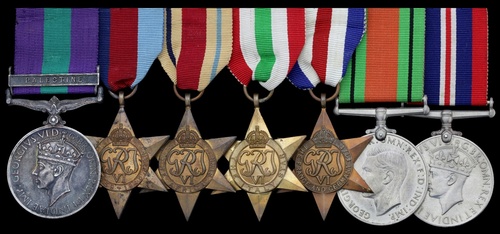
Auction: 20001 - Orders, Decorations and Medals - conducted behind closed doors
Lot: 991
Seven: Sergeant W. Brown, Argyll and Sutherland Highlanders, who had a quite remarkable war, having served in the Western Desert and been captured on Crete, he hit a 'home run' and escaped from prisoner of war camp in Turkey, only to be killed in action in North West Europe in October 1944
General Service 1918-62, 1 clasp, Palestine (2982310 Pte. W. Brown. A. & S. H.); 1939-45 Star; Africa Star; Italy Star; France and Germany Star; Defence and War Medals, good very fine (7)
William Brown, a native of Wakley, Sheffield, was born in 1920 and first saw active service in Palestine. By the time of the Second World War he was serving with the 1st Battalion and was unfortunate enough to find himself on Crete in May 1941, facing swathes of German paratroopers who took the island, with Brown going 'in the bag' on 23 May. Having been posted as interned as a prisoner of war in Turkey, Brown would appear to have made an escape for he was subsequently posted 'now not interned'.
Re-joining the 7th Battalion, he landed in Normandy but his curtail call would come during the attacks on St. Michelsgestel and Vught on 25 October 1944. Captain I. C. Cameron's The History of the 7th Argylls takes up the story:
'It was decided to push two thrusts for the crossing of the Halsche Water at Halder, and during the afternoon a class 111 raft was constructed and the 1st Black Watch formed a bridgehead on the other side with two companies. This crossing was subjected to heavy enemy shelling, and on the night of the 24th October a Kapok bridge and class 9 and class 40 bridges were built, and the remainder of the 1st Black Watch crossed. An early morning patrol from the 1st Black Watch bumped into enemy infantry, and it was then estimated that the enemy in this area were fairly strong.
As the country beyond the River Dommel at St. Michelsgestel was flooded, it was decided to develop the thrust made by the 1st Black Watch only, and so, at 8.30 am on the morning of the 25th October, the 7th Argylls, with in support one squadron of the 2nd Derby Yeomanry, crossed the bridge and passed through the 1st Black Watch, their objective being the town of Vught. Their axis of advance was along the road running north to Vught.
The order of march was D company under Major Boyle leading. D company was supported by flamethrowers and two troops of the 1st Northampton Yeomanry. After this came the remainder of the battalion. Trouble soon started when a road block was encountered, and three of our tanks were knocked out by an 88-mm. gun. Considerable opposition was then encountered from enemy infantry, and numerous snipers who were hidden in the buildings en route gave a lot of trouble. In addition the enemy shelling and mortaring was very heavy. About half-way to Vught, the battalion ran into very strong opposition and a pitched battle ensued.
It was later discovered on interrogating prisoners that the enemy were launching an attack at approximately the same time as the one launched by the battalion, and the unusual experience of two attacking parties clashing gave us a few anxious moments. Prisoners were taken on both sides, and the battalion destroyed a German self-propelled gun and an anti-tank gun.
A company were pushed forward to support D company on their left, but did not make much progress. Later B company were committed on the right and managed to advance a little despite heavy spandau and mortar fire. It was an exhausting day for the Argylls, and after having fought for every inch of their advance.'
Brown was killed during the action and is buried in the Groesbeek Canadian War Cemetery, besides being commemorated upon a memorial at St. Mary's, Wakley; sold with copied research.
Subject to 20% VAT on Buyer’s Premium. For more information please view Terms and Conditions for Buyers.
Sold for
£380
Starting price
£100




